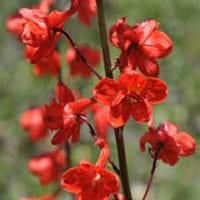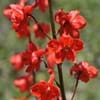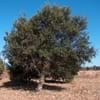Life Span
Perennial
Perennial
Type
Flowering Plants, Ornamental Plants, Shrubs
Flowering Plants, Fruits, Trees
Origin
Africa
Anatolia, Asia, Europe, Iran, Maghreb, Morocco, Norway, The Hiamalayas
Types
Not Available
Flowering Cherries, Sour Cherries, Sand Cherries, Sweet Cherries, Capulin Cherries
Habitat
gardens, meadows
Forest edges, Wild, Woods
USDA Hardiness Zone
Not Available
4-8
AHS Heat Zone
12 - 6
10-1
Sunset Zone
Not Available
4, 5, 6, 7, 15, 16, 17
Habit
Upright/Erect
Upright/Erect
Minimum Width
Not Available
Flower Color
Red, Rose
White
Flower Color Modifier
Bicolor
Not Available
Fruit Color
Not Available
Red
Leaf Color in Spring
Green
Dark Green
Leaf Color in Summer
Light Green
Orange
Leaf Color in Fall
Green, Yellow green
Orange
Leaf Color in Winter
Green, Light Yellow, Tan
Orange
Leaf Shape
Palmate and toothed
Oblong
Plant Season
Spring, Summer, Fall, Winter
Spring, Summer
Sunlight
Full Sun, Partial Sun
Full Sun, Partial shade
Type of Soil
Clay, Loam, Sand
Loamy, Well drained
The pH of Soil
Acidic, Neutral, Alkaline
Slightly Acidic
Soil Drainage
Well drained
Average
Bloom Time
Not Available
Early Spring, Spring
Tolerances
Heat And Humidity
Heat And Humidity, Not Available
Where to Plant?
Ground, Pot
Ground
How to Plant?
Seedlings, Stem Cutting
Grafting, Seedlings, Transplanting
Plant Maintenance
Medium
Medium
Watering Requirements
It cannot sustain wet-feet, Keep ground moist, Requires regular watering, Water more in summer
Never Over-water, Over-watering can cause leaf problems or root diseases, Prefer drip-irrigation instead of Over-head watering, Water twice a day in the initial period
In Summer
Lots of watering
Lots of watering
In Spring
Moderate
Moderate
In Winter
Average Water
Average Water
Soil pH
Acidic, Neutral, Alkaline
Slightly Acidic
Soil Type
Clay, Loam, Sand
Loamy, Well drained
Soil Drainage Capacity
Well drained
Average
Sun Exposure
Full Sun, Partial Sun
Full Sun, Partial shade
Pruning
Cut away fading foliage, Do not prune during shooting season, Remove damaged leaves, Remove deadheads
Don't prune in the fall, Prune if you want to improve plant shape, Prune in late winter, Remove dead or diseased plant parts, Remove deadheads
Fertilizers
High-phosphorous fertilizers used, Organic Flower Fertilizer
All-Purpose Liquid Fertilizer
Pests and Diseases
Bacterial leaf spot, fungus, Mealybugs
Aphids, Bacterial Canker, Black Knot, Brown Rot, Caterpillars
Plant Tolerance
Heat And Humidity
Drought
Flower Petal Number
Single
Not Available
Foliage Texture
Fine
Not Available
Foliage Sheen
Matte
Not Available
Attracts
Butterflies
Birds
Allergy
Severe allergen, Skin irritation, Skin rash, Throat itching, Vomiting
Swelling in the face
Aesthetic Uses
Beautification, Borders, Showy Purposes, Used for decorating walls, fences, gates, hedges, etc.
Showy Purposes
Beauty Benefits
Not Available
Not Available
Environmental Uses
Air purification
Air purification
Medicinal Uses
Not Available
Arthritis, Gout, Kidney problems, Rheumatoid arthritis, Swelling
Part of Plant Used
Flowers
Flowers, Fruits
Other Uses
Used in making blue ink
Wood is used for making furniture
Used As Indoor Plant
No
No
Used As Outdoor Plant
Yes
Yes
Garden Design
Edging, Feature Plant
Not Available
Botanical Name
Delphinium cardinale
Prunus avium
Common Name
Scarlet larkspur, Cardinal larkspur
Cherry Tree
In Hindi
लाल रंग Delphinium
चेरी का पेड़
In German
Scarlet Delphinium
Kirschbaum
In French
Scarlet Delphinium
Cerisier
In Spanish
Scarlet Delphinium
Cerezo
In Greek
Scarlet Δελφίνιο
κερασιά
In Portuguese
Scarlet Delphinium
árvore de cereja
In Polish
Scarlet Delphinium
wiśniowe drzewo
In Latin
Delphinium coccino
Cherry
Phylum
Tracheophyta
Magnoliophyta
Class
Magnoliopsida
Magnoliopsida
Order
Ranunculales
Rosales
Family
Ranunculaceae
Rosaceae
Clade
Angiosperms, Eudicots
Angiosperms, Eudicots, Rosids
Tribe
Not Available
Not Available
Subfamily
Not Available
Not Available
Number of Species
Not Available
Properties of Scarlet Delphinium and Cherry Tree
Wondering what are the properties of Scarlet Delphinium and Cherry Tree? We provide you with everything About Scarlet Delphinium and Cherry Tree. Scarlet Delphinium doesn't have thorns and Cherry Tree doesn't have thorns. Also Scarlet Delphinium does not have fragrant flowers. Scarlet Delphinium has allergic reactions like Severe allergen, Skin irritation, Skin rash, Throat itching and Vomiting and Cherry Tree has allergic reactions like Severe allergen, Skin irritation, Skin rash, Throat itching and Vomiting. Compare all the properties and characteristics of these two plants. Find out which of these plant can be used as indoor plant. If you are interested to decorate your house and garden, find out aesthetic uses, compare them and select the plant which will beautify your surrounding. Along with beautification, try comparing medicinal and edible uses of Scarlet Delphinium and Cherry Tree and you can choose the plant having best and most benefits.
Season and Care of Scarlet Delphinium and Cherry Tree
Season and care of Scarlet Delphinium and Cherry Tree is important to know. While considering everything about Scarlet Delphinium and Cherry Tree Care, growing season is an essential factor. Scarlet Delphinium season is Spring, Summer, Fall and Winter and Cherry Tree season is Spring, Summer, Fall and Winter. The type of soil for Scarlet Delphinium is Clay, Loam, Sand and for Cherry Tree is Loamy, Well drained while the PH of soil for Scarlet Delphinium is Acidic, Neutral, Alkaline and for Cherry Tree is Slightly Acidic.
Scarlet Delphinium and Cherry Tree Physical Information
Scarlet Delphinium and Cherry Tree physical information is very important for comparison. Scarlet Delphinium height is 200.00 cm and width Not Available whereas Cherry Tree height is 17.50 cm and width 17.50 cm. The color specification of Scarlet Delphinium and Cherry Tree are as follows:
Scarlet Delphinium flower color: Red and Rose
Scarlet Delphinium leaf color: Green
Cherry Tree flower color: White
- Cherry Tree leaf color: Dark Green
Care of Scarlet Delphinium and Cherry Tree
Care of Scarlet Delphinium and Cherry Tree include pruning, fertilizers, watering etc. Scarlet Delphinium pruning is done Cut away fading foliage, Do not prune during shooting season, Remove damaged leaves and Remove deadheads and Cherry Tree pruning is done Don't prune in the fall, Prune if you want to improve plant shape, Prune in late winter, Remove dead or diseased plant parts and Remove deadheads. In summer Scarlet Delphinium needs Lots of watering and in winter, it needs Average Water. Whereas, in summer Cherry Tree needs Lots of watering and in winter, it needs Average Water.





